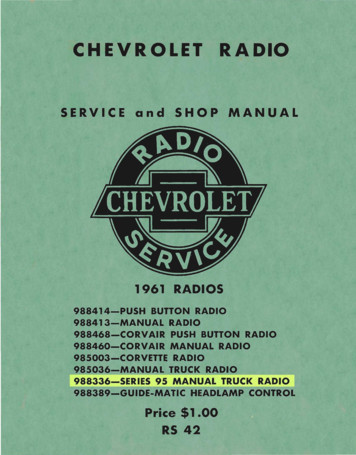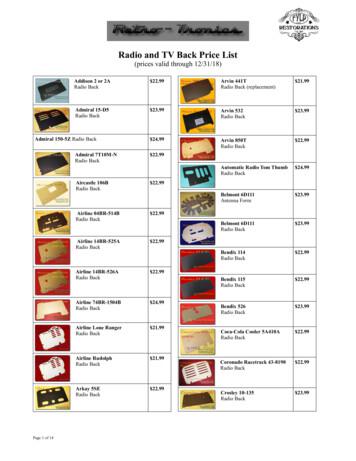Sample Radio Calls - AOPA
Page 1 of 7For use in chartor flight planningringdashed linesandinpunchas neededAll requirementscitedarebinders,for Partcut91alongoperations.For usechartholesor flightin ngoptionto“None”or“100%.”planning ring binders, cut along dashed lines and punch holes where indicatedSample Radio CallsThe following sample communications will help you frame varioustypes of radio calls.When in doubt, remember the four Ws: Who you’re calling Who you are Where you are What you wantDepartingClass D AirspaceWhen ready to taxi:Pilot: Lancaster Ground, Cherokee 8121K, west ramp, VFR,4,500 to Frederick with [information] Sierra.Ground: Cherokee 8121K, Lancaster Ground, taxi to Runway26.Pilot: Taxi to Runway 26, Cherokee 8121K.When ready for takeoff:Pilot: Lancaster Tower, Cherokee 8121K, Runway 26, readyfor takeoff.Tower: Cherokee 8121K, Runway 26, cleared for takeoff.Pilot: Cleared for takeoff Runway 26, Cherokee 8121K.ArrivingPilot: Lancaster Tower, Cherokee 8121K, 10 [miles] southwestat 2,500, inbound for landing with [information] Sierra.Tower: Cherokee 8121K, Lancaster Tower, report entering leftdownwind Runway 31.Pilot: Report entering left downwind, Cherokee 8121K. . . . .Pilot: Cherokee 8121K entering left downwind Runway 31.Tower: Cherokee 21K, cleared to land Runway 31.Pilot: Cleared to land Runway 31, Cherokee 21K.Mastering Radio CommunicationReview full course online anytime TITUTE.ORG/RADIOCOMM
Page 2 of 7Class C or TRSA AirspaceDepartingWhen ready to taxi:Pilot: Greensboro Ground, Cherokee 8121K, general aviationramp, VFR, 5,500 to Raleigh with [information] Sierra.Ground: Cherokee 8121K, Greensboro Ground, cleared toRaleigh, maintain VFR at or below 3,000, departurefrequency 118.5, squawk 4234, advise when ready totaxi.Pilot: Cherokee 8121K is cleared to Raleigh, maintain VFRat or below 3,000, departure frequency 118.5, squawk4234, we’re ready to taxi.Ground: Cherokee 21K, taxi to Runway 23.Pilot: Taxi to Runway 23, Cherokee 21K.When ready for takeoff:Pilot: Greensboro Tower, Cherokee 8121K, Runway 23,ready for takeoff.Tower: Cherokee 8121K, Runway 23, cleared for takeoff.Pilot: Cleared for takeoff, Runway 23, Cherokee 8121K.ArrivingPilot: Greensboro Approach, Cherokee 8121K, 20 [miles]west at 5,500, landing with [information] Foxtrot.ATC: Cherokee 8121K, Greensboro Approach, squawk 2150and ident.Pilot: Squawk 2150, Cherokee 8121K.ATC: Cherokee 21K, radar contact, fly heading 110, descendand maintain 4,500, maintain VFR.Pilot: Fly heading 110, descend and maintain 4,500, maintainVFR, Cherokee 21K.Mastering Radio CommunicationReview full course online anytime TITUTE.ORG/RADIOCOMM
Page 3 of 7DepartingClass B AirspaceClass B departure calls follow the same format as Class C orTRSA airspace. However, you may need to contact ClearanceDelivery prior to calling Ground and provide them the four Ws.ArrivingPilot: Charlotte Approach, Cherokee 8121K, 20 [miles]southwest at 7,500, landing Charlotte with [information]Charlie.ATC: Cherokee 8121K, Charlotte Approach, squawk 4323and ident.Pilot: Squawk 4323, Cherokee 8121K.ATC: Cherokee 21K, radar contact, cleared to enter ClassBravo airspace, fly heading 020, descend and maintain3,000, maintain VFR.Pilot: Cleared to enter Class Bravo airspace, fly heading 020,descend and maintain 3,000, maintain VFR,Cherokee 21K.TransitingPilot: Seattle Approach, Cherokee 8121K, 20 [miles] southwestof Seattle VOR at 7,500, en route Arlington, requesttransit Class Bravo airspace.ATC: Cherokee 8121K, Seattle Approach, squawk 3121and ident.Pilot: Squawk 3121, Cherokee 8121K.ATC: Cherokee 21K, radar contact 18 miles southwest ofSeaTac, Seattle altimeter 29.88, cleared through ClassBravo direct Arlington, descend and maintain 5,500,maintain VFR.Pilot: Cleared through Class Bravo direct Arlington, descendand maintain 5,500, maintain VFR, Cherokee 21K.Mastering Radio CommunicationReview full course online anytime TITUTE.ORG/RADIOCOMM
Page 4 of 7Opening a VFR Flight PlanPilot: Raleigh Radio, Cherokee 8121K on 122.2.Flight Service: Cherokee 8121K, Raleigh Radio, go ahead.Pilot: Raleigh Radio, open flight plan for Cherokee8121K from Greensboro to Knoxville at 1835 Zulu.Flight Service: Cherokee 21K, flight plan activated at 1835 Zulu,Greensboro altimeter 30.02. We’d appreciate anypilot reports on Flight Watch, 122.0.Requesting/Canceling Flight FollowingRequestingPilot: Manchester Approach, Cherokee 8121K.ATC: Cherokee 8121K, Manchester Approach.Pilot: Cherokee 8121K over Concord VOR at 6,500, en routeTrenton Mercer, request flight following.ATC: Cherokee 21K, squawk 3314.Pilot: Squawk 3314, Cherokee 21K.CancelingPilot: Manchester Approach, Cherokee 8121K would like tocancel flight following.ATC: Cherokee 8121K, radar service terminated, squawkVFR, frequency change approved.Pilot: Squawk VFR, Cherokee 8121K.Mastering Radio CommunicationReview full course online anytime TITUTE.ORG/RADIOCOMM
Page 5 of 7Clearance ComponentsMost IFR clearances consist of five basic components (“CRAFT”): Clearance limit: Your destination airport or an intermediate fix. Route of flight: Hopefully the route you filed, unless trafficconditions dictate otherwise. Altitude: If not as requested, typically followed by when to expectclimb or descent clearance. Frequency: The radio frequency for departure control. Transponder: Your four-digit squawk code.Position Report ComponentsInclude the following items when making a position report (“IPATTEN”): Identification Position Altitude Time Type of flight plan* ETA to next reporting point Name of next reporting point* Not required in IFR position reports made directly to ATC centers or approach control.Lost Comm Route and AltitudeIf two-way IFR communication is lost, select a route and altitude basedon the acronyms below, or follow the simple flowchart on the reverseside of this reference.Route (choose based on “AVEF” hierarchy):1. Assigned—the route assigned in the last ATC clearance2. Vectored—if being radar vectored, direct to the fix, route,or airway specified3. Expected—the route ATC said to expect in a further clearance4. Filed—the route filed in your flight planAltitude (fly the highest of “MEA”): Minimum—the minimum en route altitude Expected—the altitude ATC said to expect in a further clearance Assigned—the altitude ATC assigned in the last clearanceMastering Radio CommunicationReview full course online anytime TITUTE.ORG/RADIOCOMM
Page 6 of 7IFR Two-Way Radio CommunicationsFailure Procedures: FAR 91.185Step 1: Route ProceduresWhat environment are you flying in?IFRWas a routeassigned by ATC?YesFly that routeVFRLand as soonas practicalNoAre you beingradar vectored?YesIs therean EFC route?Fly directly to the fix,route, or airway specifiedin the clearanceNoFly the route specified inthe EFC clearanceFly your flightplan routeStep 2: Altitude ProceduresFly the highest of the following:Altitude assigned by ATCORMinimum altitude for IFRoperations using currentaltimeter settingORAltitude expected infurther clearanceStep 3: Leave Clearance LimitIs the clearance limit a fix from which an approach begins?YesYesDid you receive anEFC time?Commence descentor descent andapproach as close aspossible to EFC timeYesCommence descentor descent andapproach as close aspossible to the ETAMastering Radio CommunicationNoDid you receive anEFC time?Leave clearance limitat the EFC time andproceed to a fix fromwhich an approachbegins; commencedescent or descentand approach asclose as possible tothe ETANoUpon arrival overthe clearance limit,proceed to a fix fromwhich an approachbegins; commencedescent or descentand approach asclose as possible tothe ETAReview full course online anytime TITUTE.ORG/RADIOCOMM
Page 7 of 7ATC Light Gun SignalsMEANINGColor and typeof signalMovement ofvehicles equipmentand personnelAircraft on thegroundAircraft in flightCleared for takeoffCleared to landCleared to cross;proceed; go Flashing greenCleared to taxiReturn for landing(to be followed bysteady green at theproper time)Not applicableSteady redStopGive way toother aircraft andcontinue circlingStopTaxi clear of landingarea or runway in useAirport unsafeDo not landClear thetaxiway/runwayReturn tostarting pointon airportNot applicableReturn tostarting pointon airportGeneralwarning signal –exercise extremecautionGeneralwarning signal –exercise extremecautionGeneralwarning signal –exercise extremecautionSteady greenFlashing redFlashing white Alternating redand greenReply with one of the following acknowledgements:Fixed-wing aircraftHelicoptersBetween sunrise and sunset:(a) M ove ailerons or rudder whileon the ground.Between sunrise and sunset:(a) W hile hovering, either turnthe helicopter toward thecontrolling facility and flashthe landing light or rock thetip path plane.(b) Rock wings while in flight.Between sunset and sunrise:(a) F lash landing light ornavigation lights.(b) W hile in flight, either flash thelanding light or rock the tippath plane.Between sunset and sunrise:(a) F lash navigation lights orlanding light.Mastering Radio CommunicationReview full course online anytime TITUTE.ORG/RADIOCOMM
Pilot: Raleigh Radio, open flight plan for Cherokee 8121K from Greensboro to Knoxville at 1835 Zulu. Flight Service: Cherokee 21K, flight plan activated at 1835 Zulu, Greensboro altimeter 30.02. We’d appreciate any pilot reports on Flight Watch, 122.0. Requesting/Canceling Flight Following
AIRSPACE FLASHCARDS Courtesy of the Air Safety Institute, a Division of the AOPA Foundation, and made possible by AOPA Holdings
AOPA Air Safety Institute’s online flight instructor refresher course is tablet-friendly, so CFIs can work through the course no matter where they are. I love the advice you guys post! You encourage safe flying and help students like myself and guys with thousands of hours be better pilots! I love all the resources you provide. Proud AOPA
Recent calls is a list of placed, missed and received calls since the last time you cleared the list. Calls placed Calls received Calls missed Tap . Recent calls . to display the list of recent calls. Scroll by dragging up or down anywhere in . these lists. Tap the entry to be called. This will cause the . Call. button to appear. Tap to display .
SERVICE and SHOP MANUAL 1961 RADIOS 988414-PUSH BUTTON RADIO 988413-MANUAL RADIO 988468-CORVAIR PUSH BUTTON RADIO 988460-CORVAIR MANUAL RADIO 985003-CORVETTE RADIO 985036-MANUAL TRUCK RADIO 988336-SERIES 95 MANUAL TRUCK RADIO 988389-GUIDE-MATIC HEADLAMP CONTROL Price 1.00 . 89 switch and must be opened by speaker plug when testing radio.
Wavestown Answer Key Radio Waves Ray’s TV - TV reception uses radio waves Satellite Dish on top Ray’s - receives movies via radio waves from a satellite Taxi - Car radio reception uses radio signals Taxi - Driver receives instructions on a CB radio which uses radio waves Radio Tower - broadcast’s radio signals
Radio and TV Back Price List (prices valid through 12/31/18) Addison 2 or 2A Radio Back 22.99 Admiral 15-D5 Radio Back 23.99 Admiral 150-5Z Radio Back 24.99 Admiral 7T10M-N Radio Back 22.99 Aircastle 106B Radio Back 22.99 Airline 04BR-514B Radio Back 22.99 Airline 14BR-525A Radio Ba
Using BT Cloud Voice voicemail Call Diversion 1. If you divert all your calls Calls are diverted to the number you've chosen straight away. 2. If you divert calls that you don't answer Calls are diverted to the number you've chosen. Cloud Voice voicemail takes any new calls when you're engaged. 3. If you divert calls when you're engaged
image as a guide. Fill in a few petals using satin stitch, and add . The secret is to hold the working thread taut while you pull it through. Come up at point 1, then wrap the thread around the needle twice. Holding the working thread with your non-dominant hand, bring the needle down at point 2 (close to point 1, but not the same hole) and pull slowly until the knot is formed. 01 01 01 .






















